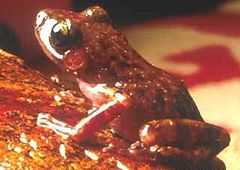Leptodactylidae
| Leptodactylids Temporal range: Late Cretaceous – Holocene[1] 70–0Ma | |
|---|---|
 | |
| Eleutherodactylus guttilatus | |
| Scientific classification | |
| Kingdom: | Animalia |
| Phylum: | Chordata |
| Class: | Amphibia |
| Order: | Anura |
| Superfamily: | Hyloidea |
| Family: | Leptodactylidae Werner, 1896 |
| Subfamilies | |
| |
| | |
| Distribution of Leptodactylidae (in black) | |
The Southern Frogs form Leptodactylidae, a diverse family of frogs that probably diverged from other hyloids during the Cretaceous.[2] Of the roughly 50 genera, one, Eleutherodactylus, is the largest vertebrate genus, with over 700 species. In total, the approximately 1100 leptodactylid species are widely distributed throughout Mexico, the Caribbean, and Central and South America. The family is often considered paraphyletic and has no morphological synapomorphies.[3] The family includes terrestrial, burrowing, aquatic, and arboreal members, inhabiting a wide range of different habitats.[1]
Several of the genera within Leptodactylidae lay their eggs in foam nests. These can be in crevices, on the surface of water, or on forest floors. These foam nests are some of the most varied among frogs. When eggs hatch in nests on the forest floor, the tadpoles remain within the nest, without eating, until metamorphosis. In the genus Eleutherodactylus, the eggs undergo direct development and hatch directly into miniature frogs, with no free-living tadpole stage.[1]
Leptodactylids are well represented in the fossil record, and one specimen from the genus Eleutherodactylus was wholly preserved in amber 37 million years ago.[1]
Classification
As of 2014, the Amphibian Species of the World uses the following classification:[4]
- Leiuperinae Bonaparte, 1850 (90 species)
- Edalorhina Jiménez de la Espada, 1870
- Engystomops Jiménez de la Espada, 1872
- Physalaemus Fitzinger, 1826
- Pleurodema Tschudi, 1838
- Pseudopaludicola Miranda-Ribeiro, 1926
- Leptodactylinae Werner, 1896 (1838) (98 species)
- Adenomera Steindachner, 1867
- Hydrolaetare Gallardo, 1963
- Leptodactylus Fitzinger, 1826
- Lithodytes Fitzinger, 1843
- Paratelmatobiinae Ohler and Dubois, 2012 (13 species)
- Crossodactylodes Cochran, 1938
- Paratelmatobius Lutz and Carvalho, 1958
- Rupirana Heyer, 1999
- Scythrophrys Lynch, 1971
This earlier classification is still partly in use in Wikipedia:
- Subfamily Ceratophryinae – horned frogs
- Subfamily Cycloramphinae
- Subfamily Eleutherodactylinae – robber frogs
- Subfamily Leptodactylinae
- Subfamily Telmatobiinae – water frogs
References
- ↑ 1.0 1.1 1.2 1.3 Zweifel, Richard G. (1998). Cogger, H.G. & Zweifel, R.G., ed. Encyclopedia of Reptiles and Amphibians. San Diego: Academic Press. pp. 89–90. ISBN 0-12-178560-2.
- ↑ Heinicke, M.P., W.E. Duellman & S.B. Hedges (2007). "Major Caribbean and Central American frog faunas originated by ancient oceanic dispersal". Proc. Nat. Acad. Sci. 104 (24): 10092–7. doi:10.1073/pnas.0611051104. PMC 1891260. PMID 17548823.
- ↑ "AmphibiaWeb: Information on Amphibian Biology and Conservation". University of California, Berkeley, CA. Retrieved 2007-06-17.
- ↑ Frost, Darrel R. (2014). "Leptodactylidae Werner, 1896 (1838)". Amphibian Species of the World: an Online Reference. Version 6.0. American Museum of Natural History. Retrieved 1 August 2014.
External links
- Leptodactylidae, from the Tree of Life Web Project
- Leptodactylidae taxonomy, from the NCBI taxonomy browser
- Leptodacylidae classification, from Animal Diversity Web
- Leptodactylid description, from AmphibiaWeb
| |||||||||||||||||||||